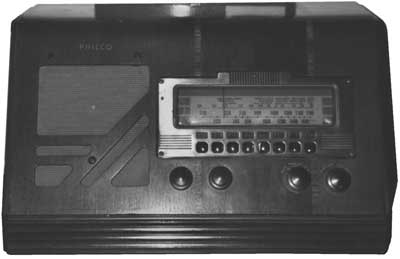Of Old Radios And Related Items--Published Monthly
Philco and the Years Leading to
the Model 39-25BY RICHARD ARNOLD
WEB EDITION
Once again, Richard Arnold presents a little history of a company’s rise in the radio manufacturing industry — in this case, Philco. He then zeroes in on a particularly attractive table model of the late 1930s. (Editor)
By 1928, when the Philadelphia Storage and Battery Company, known as Philco, made a decision to get into the radio receiver manufacturing business, radio had come a long way. From 1922 to 1924 alone, more than 3,000,000 radio sets were sold, 560 commercial broadcasting stations were in operation in the United States, and 16,000 amateur transmitters were in use. There were 12 transoceanic stations communicating with Europe and Latin America and 2,700 radio-equipped ships.
The 20,000,000 listeners constituting the 1924 radio audience spent $175,000,000 on radio equipment, giving, in turn, employment to one-half million people. In addition, 3,000 manufacturers were turning out sets or parts of sets, 30 radio magazines had been started, and 250 books on the subject had been published.
Since RCA had all the patents sewed up and was reluctant to issue new licenses, it was no easy task for Philco to enter the competition. However, in February 1928, Philco purchased the William J. Murdock Company for $100,000 and acquired Murdock’s license to manufacture TRF sets. RCA honored this arrangement.
At first, there were no real problems. Philco started to make its own hand-painted, metal cabinet receivers and sold them directly to the public. RCA received 7.5 percent of the entire package price. Philco was also required to purchase all tubes from RCA.
In 1932, Philco split into two separate companies and established the Philco Radio and Television Company. This was an effort to reduce still further the RCA royalties, which had diminished to 5 percent for domestic sets and 2.5 percent for exports. After a court battle, the Supreme Court of Delaware found in favor of Philco, and RCA was forced to reduce royalties across the board to 2.4 percent of the net selling price for everyone.
The Model 39-25
By 1940, just a year after the Model 39-25 had been introduced, Philco too had come a long way. The company had sold 1,675,000 radio sets, and was surpassed only by RCA with its 1,700,000 record of sets sold.
Figure 1. The Philco Model 39-25.
The Philco Model 39-25, shown in Figure 1, was among the more popular models. This slant-front table set is a 5-tube superheterodyne and measures 18 1/2" x 10 3/4" x 10". It has a Deco design speaker grille and push buttons. The frequency bands are a standard broadcast band covering 540 to 1720 Kc and shortwave band capability of 4.9 to 18.0 Mc.
The set uses a conventional pully and dial-cord drive for manual tuning and 8 push buttons for the automatic tuning. The frequency tuning ranges of the push buttons are as follows:
Buttons 1 and 2: 540-1030 Kc.
Buttons 3 and 4: 670-1160 Kc
Buttons 5 and 6: 900-14790 Kc
Buttons 7 and 8: 1170-1600 Kc
The tube complement consists of the following types: 6A8G detector and oscillator; 78 IF; 75 2nd detector, AVC, 1st audio; 84/6Z4 rectifier; 41 audio output.
The style of the Model 39-25 continued to be popular through at least 1942. Today, it shows up at events like the Vintage Radio and Phonograph Society fall auction in Dallas, Texas, where I saw it as a contest entry.
References:
Bliven, Bruce. “How Radio is Remaking Our World.” The Century Magazine, June 1924.
Herrington, Donald. How to Read Schematic Drawings. Howard W. Sams and Co., 1962.
MacLaurin, W. Rupert. Invention and Innovation in the Radio Industry, 1949.
Ramirez, Ron. Philco Radio 1928-1942. Atglen, Pa.: Schiffer Publishing, Ltd., 1993.
(Richard Arnold, Box 275, Lone Grove, OK 73443)
Richard Arnold, a frequent contributor to A.R.C., has been collecting radios since 1985. His interest is primarily in cathedrals and 1920s battery sets, and his collection ranges from crystal sets to a 1928 American Bosch in a Pooley cabinet. His prize is the 1932 JB Peter Pan featured in the June 1991 A.R.C.
| [Free Sample] [Books, etc., For Sale] [Subscribe to A.R.C./Renew] [Classified Ads] [Auction Prices] [Event Calendar] [Links] [Home] [Issue Archives] [Book Reviews] [Subscription Information] [A.R.C. FAQ] URL = http://www.antiqueradio.com/arnold_philco_39-25.html Copyright © 1996-2000 by John V. Terrey - For personal use only. Last revised: July 28, 2000. For Customer Assistance please contact ARC@antiqueradio.com or call (978) 371-0512 Pages designed/maintained by Wayward Fluffy Publications
Antique Radio Classified |
